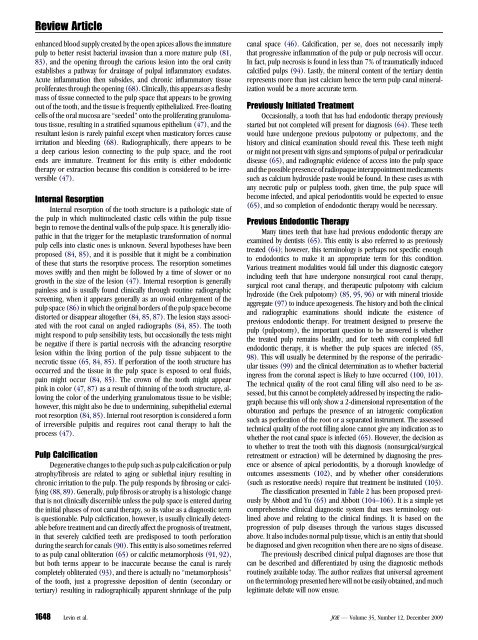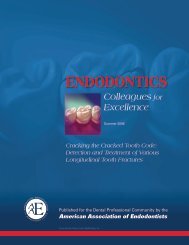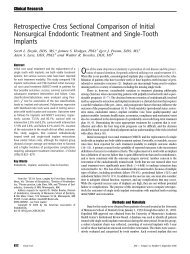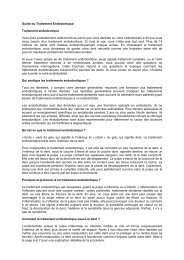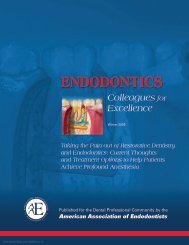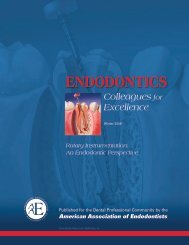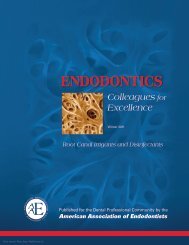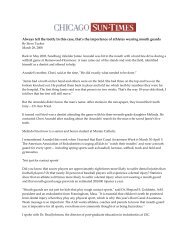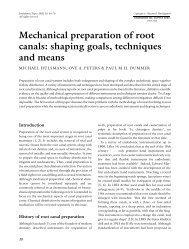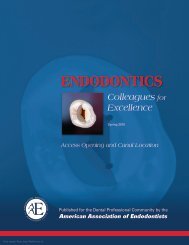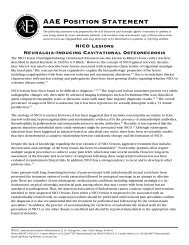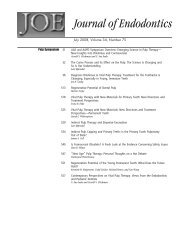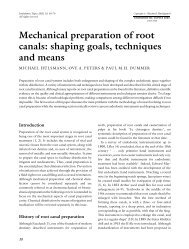Identify and Define All Diagnostic Terms for Pulpal - American ...
Identify and Define All Diagnostic Terms for Pulpal - American ...
Identify and Define All Diagnostic Terms for Pulpal - American ...
Create successful ePaper yourself
Turn your PDF publications into a flip-book with our unique Google optimized e-Paper software.
Review Article<br />
enhanced blood supply created by the open apices allows the immature<br />
pulp to better resist bacterial invasion than a more mature pulp (81,<br />
83), <strong>and</strong> the opening through the carious lesion into the oral cavity<br />
establishes a pathway <strong>for</strong> drainage of pulpal inflammatory exudates.<br />
Acute inflammation then subsides, <strong>and</strong> chronic inflammatory tissue<br />
proliferates through the opening (68). Clinically, this appears as a fleshy<br />
mass of tissue connected to the pulp space that appears to be growing<br />
out of the tooth, <strong>and</strong> the tissue is frequently epithelialized. Free-floating<br />
cells of the oral mucosa are ‘‘seeded’’ onto the proliferating granulomatous<br />
tissue, resulting in a stratified squamous epithelium (47), <strong>and</strong> the<br />
resultant lesion is rarely painful except when masticatory <strong>for</strong>ces cause<br />
irritation <strong>and</strong> bleeding (68). Radiographically, there appears to be<br />
a deep carious lesion connecting to the pulp space, <strong>and</strong> the root<br />
ends are immature. Treatment <strong>for</strong> this entity is either endodontic<br />
therapy or extraction because this condition is considered to be irreversible<br />
(47).<br />
Internal Resorption<br />
Internal resorption of the tooth structure is a pathologic state of<br />
the pulp in which multinucleated clastic cells within the pulp tissue<br />
begin to remove the dentinal walls of the pulp space. It is generally idiopathic<br />
in that the trigger <strong>for</strong> the metaplastic trans<strong>for</strong>mation of normal<br />
pulp cells into clastic ones is unknown. Several hypotheses have been<br />
proposed (84, 85), <strong>and</strong> it is possible that it might be a combination<br />
of these that starts the resorptive process. The resorption sometimes<br />
moves swiftly <strong>and</strong> then might be followed by a time of slower or no<br />
growth in the size of the lesion (47). Internal resorption is generally<br />
painless <strong>and</strong> is usually found clinically through routine radiographic<br />
screening, when it appears generally as an ovoid enlargement of the<br />
pulp space (86) in which the original borders of the pulp space become<br />
distorted or disappear altogether (84, 85, 87). The lesion stays associated<br />
with the root canal on angled radiographs (84, 85). The tooth<br />
might respond to pulp sensibility tests, but occasionally the tests might<br />
be negative if there is partial necrosis with the advancing resorptive<br />
lesion within the living portion of the pulp tissue subjacent to the<br />
necrotic tissue (65, 84, 85). If per<strong>for</strong>ation of the tooth structure has<br />
occurred <strong>and</strong> the tissue in the pulp space is exposed to oral fluids,<br />
pain might occur (84, 85). The crown of the tooth might appear<br />
pink in color (47, 87) as a result of thinning of the tooth structure, allowing<br />
the color of the underlying granulomatous tissue to be visible;<br />
however, this might also be due to undermining, subepithelial external<br />
root resorption (84, 85). Internal root resorption is considered a <strong>for</strong>m<br />
of irreversible pulpitis <strong>and</strong> requires root canal therapy to halt the<br />
process (47).<br />
Pulp Calcification<br />
Degenerative changes to the pulp such as pulp calcification or pulp<br />
atrophy/fibrosis are related to aging or sublethal injury resulting in<br />
chronic irritation to the pulp. The pulp responds by fibrosing or calcifying<br />
(88, 89). Generally, pulp fibrosis or atrophy is a histologic change<br />
that is not clinically discernible unless the pulp space is entered during<br />
the initial phases of root canal therapy, so its value as a diagnostic term<br />
is questionable. Pulp calcification, however, is usually clinically detectable<br />
be<strong>for</strong>e treatment <strong>and</strong> can directly affect the prognosis of treatment,<br />
in that severely calcified teeth are predisposed to tooth per<strong>for</strong>ation<br />
during the search <strong>for</strong> canals (90). This entity is also sometimes referred<br />
to as pulp canal obliteration (65) or calcific metamorphosis (91, 92),<br />
but both terms appear to be inaccurate because the canal is rarely<br />
completely obliterated (93), <strong>and</strong> there is actually no ‘‘metamorphosis’’<br />
of the tooth, just a progressive deposition of dentin (secondary or<br />
tertiary) resulting in radiographically apparent shrinkage of the pulp<br />
canal space (46). Calcification, per se, does not necessarily imply<br />
that progressive inflammation of the pulp or pulp necrosis will occur.<br />
In fact, pulp necrosis is found in less than 7% of traumatically induced<br />
calcified pulps (94). Lastly, the mineral content of the tertiary dentin<br />
represents more than just calcium hence the term pulp canal mineralization<br />
would be a more accurate term.<br />
Previously Initiated Treatment<br />
Occasionally, a tooth that has had endodontic therapy previously<br />
started but not completed will present <strong>for</strong> diagnosis (64). These teeth<br />
would have undergone previous pulpotomy or pulpectomy, <strong>and</strong> the<br />
history <strong>and</strong> clinical examination should reveal this. These teeth might<br />
or might not present with signs <strong>and</strong> symptoms of pulpal or periradicular<br />
disease (65), <strong>and</strong> radiographic evidence of access into the pulp space<br />
<strong>and</strong> the possible presence of radiopaque interappointment medicaments<br />
such as calcium hydroxide paste would be found. In these cases as with<br />
any necrotic pulp or pulpless tooth, given time, the pulp space will<br />
become infected, <strong>and</strong> apical periodontitis would be expected to ensue<br />
(65), <strong>and</strong> so completion of endodontic therapy would be necessary.<br />
Previous Endodontic Therapy<br />
Many times teeth that have had previous endodontic therapy are<br />
examined by dentists (65). Thisentityisalsoreferredtoaspreviously<br />
treated (64); however, this terminology is perhaps not specific enough<br />
to endodontics to make it an appropriate term <strong>for</strong> this condition.<br />
Various treatment modalities would fall under this diagnostic category<br />
including teeth that have undergone nonsurgical root canal therapy,<br />
surgical root canal therapy, <strong>and</strong> therapeutic pulpotomy with calcium<br />
hydroxide (the Cvek pulpotomy) (85, 95, 96) or with mineral trioxide<br />
aggregate (97) to induce apexogenesis. The history <strong>and</strong> both the clinical<br />
<strong>and</strong> radiographic examinations should indicate the existence of<br />
previous endodontic therapy. For treatment designed to preserve the<br />
pulp (pulpotomy), the important question to be answered is whether<br />
the treated pulp remains healthy, <strong>and</strong> <strong>for</strong> teeth with completed full<br />
endodontic therapy, it is whether the pulp spaces are infected (85,<br />
98). This will usually be determined by the response of the periradicular<br />
tissues (99) <strong>and</strong> the clinical determination as to whether bacterial<br />
ingress from the coronal aspect is likely to have occurred (100, 101).<br />
The technical quality of the root canal filling will also need to be assessed,<br />
but this cannot be completely addressed by inspecting the radiograph<br />
because this will only show a 2-dimensional representation of the<br />
obturation <strong>and</strong> perhaps the presence of an iatrogenic complication<br />
such as per<strong>for</strong>ation of the root or a separated instrument. The assessed<br />
technical quality of the root filling alone cannot give any indication as to<br />
whether the root canal space is infected (65). However, the decision as<br />
to whether to treat the tooth with this diagnosis (nonsurgical/surgical<br />
retreatment or extraction) will be determined by diagnosing the presence<br />
or absence of apical periodontitis, by a thorough knowledge of<br />
outcomes assessments (102), <strong>and</strong> by whether other considerations<br />
(such as restorative needs) require that treatment be instituted (103).<br />
The classification presented in Table 2 has been proposed previously<br />
by Abbott <strong>and</strong> Yu (65) <strong>and</strong> Abbott (104–106). It is a simple yet<br />
comprehensive clinical diagnostic system that uses terminology outlined<br />
above <strong>and</strong> relating to the clinical findings. It is based on the<br />
progression of pulp diseases through the various stages discussed<br />
above. It also includes normal pulp tissue, which is an entity that should<br />
be diagnosed <strong>and</strong> given recognition when there are no signs of disease.<br />
The previously described clinical pulpal diagnoses are those that<br />
can be described <strong>and</strong> differentiated by using the diagnostic methods<br />
routinely available today. The author realizes that universal agreement<br />
on the terminology presented here will not be easily obtained, <strong>and</strong> much<br />
legitimate debate will now ensue.<br />
1648 Levin et al. JOE — Volume 35, Number 12, December 2009


